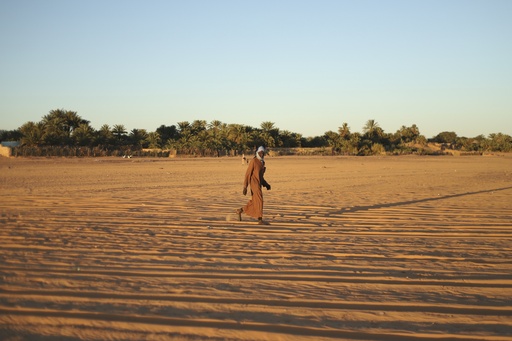
CHINGUETTI, Mauritania — Historically, Chinguetti has been a vibrant hub for poets, scholars, and theologians, serving as a crucial trans-Saharan trading post. The city is home to over a dozen libraries filled with thousands of ancient manuscripts. However, it now finds itself facing a grave threat as encroaching desert sands cover its foundational 8th-century core and steadily invade the neighborhoods surrounding the area. Many locals lament that the desert seems to be their inevitable fate.
With the world experiencing rising temperatures and increasing aridity, sandstorms have become more common, depositing substantial dunes on the streets and in homes of Chinguetti, burying certain areas completely. Although initiatives to plant trees are in place to combat the advancing sands, they have not alleviated the persistent anxiety about what lies ahead for this historic city.
Chinguetti is recognized as one of four UNESCO World Heritage sites in Mauritania, a country where only a fraction—0.5%—of the land is used for agriculture. According to World Bank data, only Somalia and Eswatini have faced more significant impacts from climate change in Africa, despite the continent contributing the least to global fossil fuel emissions.
In the eyes of Mauritanians, Chinguetti holds immense spiritual significance, often regarded as one of the holiest cities in Islam. The city’s mud and stone architecture, including mosques and libraries, preserves some of West Africa’s oldest manuscripts covering various subjects, from law to mathematics. Melainine Med El Wely, a community leader, expresses deep concern for both the residents and the historical treasures within Chinguetti. He describes the situation as akin to witnessing a natural disaster unfold in slow motion.
“It’s like living in a city that’s gradually being consumed by an advancing sea of sand,” El Wely, president of the local Association for Participatory Oasis Management, explained. He reminisces about areas he once walked on that are now buried beneath sand. He recounts a time when a wandering camel unexpectedly fell through the roof of a house because of sand accumulation.
Research indicates that the movement of sand contributes significantly to desertification. The Sahara and other deserts are expanding rapidly, with “sand seas” being rejuvenated, transforming formerly green landscapes into barren stretches. According to Andreas Baas, an earth scientist at King’s College London, what was once considered a worst-case scenario regarding desertification is now increasingly likely.
A recent 2024 U.N. report on desertification reveals that over 75% of the planet’s land has become drier in recent years, compromising the survival of plants, animals, and people alike. The dryness strips the land of moisture necessary for growth, leading to crop failures and initiating sandstorms and wildfires. The report attributes these changes largely to human-induced climate change, noting its role in reducing available water and prompting forced migration around the globe.
While scientists and policymakers often focus on soil degradation in previously fertile areas, Chinguetti is currently experiencing many of the adverse effects they caution against. Residents are grappling with wilting trees, drying wells, and vanishing livelihoods. Salima Ould Salem, a 50-year-old date farmer, finds it increasingly challenging to nurture his palm trees and now relies on water that is brought in externally. His neighborhood, once bustling with life, has witnessed families leaving, and piles of sand now block the entrance to his home. Nearby, a guesthouse built years ago has become partially engulfed in shifting dunes.
Despite the exodus, Salem remains in Chinguetti, aware that each departing neighbor exacerbates the threat to the remaining community members, making them more vulnerable to the advancing desert. “We would rather stay. If we leave, our homes will vanish,” he asserts.
Previously abundant with acacia, palm, and gum trees that protected the area from shifting dunes, the vegetation has dwindled due to both drought and the need for firewood. Although sandstorms have always existed, their frequency and severity have escalated. Residents like retired teacher Mohamed Lemine Bahane note that residents must use mules and carts to move sand, as vehicles cannot navigate the narrow streets of the older sections of the city. When accumulation becomes unmanageable, some attempt to build new barriers atop existing structures.
“The loss of vegetation allows the dunes to become more aggressive. Plants are vital in stabilizing the sand,” Bahane explains. Having tracked sand deposits and rainfall patterns, he reveals that Chinguetti has averaged just 2.5 centimeters (or one inch) of rain annually over the past decade. As rainfall diminishes, vegetation succumbs to drought, leading to an increase in sand infiltration. Short-statured acacia trees now buried in sand have led some herders to resort to cutting down date palms to feed their animals, further destabilizing both the ecosystem and the local economy. Bahane also raises concerns about health issues stemming from the dust these sands produce.
He insists that replanting trees, both within neighborhoods and on the outskirts of town, is essential. Plans for “green belts,” aimed at countering the desert’s advance, have been proposed as part of the broader “Great Green Wall” initiative across Africa. Various organizations, including Mauritania’s Ministry of Environment and Ministry of Agriculture along with European NGOs, have considered projects to plant trees to protect Chinguetti’s invaluable libraries and manuscripts.
While some reforestation efforts have been undertaken, progress has been slow and insignificant in halting the desert’s relentless advance. It typically takes years for new tree roots to penetrate deep enough into the ground to reach groundwater.
“We are resigned to the belief that desertification is our fate. Yet, thankfully, there are still those who believe in our capacity to resist it,” El Wely concludes, serving as a rallying cry for the community amidst its struggle against nature’s relentless forces.

